Finding the perfect wool garment in just the right color can be a challenge. Even if you make the clothes yourself, you might not be able to find exactly the right shade of wool fabric without breaking the bank. Luckily, if you know how to dye wool you can avoid this problem!
Wool is an easy to dye natural fiber. Adding a custom color to wool is as easy as soaking the fiber in an acid solution, adding your dye, and cooking it over low heat until the dye has set. You can use a commercial chemical dye or pick from a variety of household and botanical options.
This guide will help demystify the wool dyeing process. Whether you’re adding color to an already constructed item, undyed wool fabric, or even wool yarn, this technique can work for you.
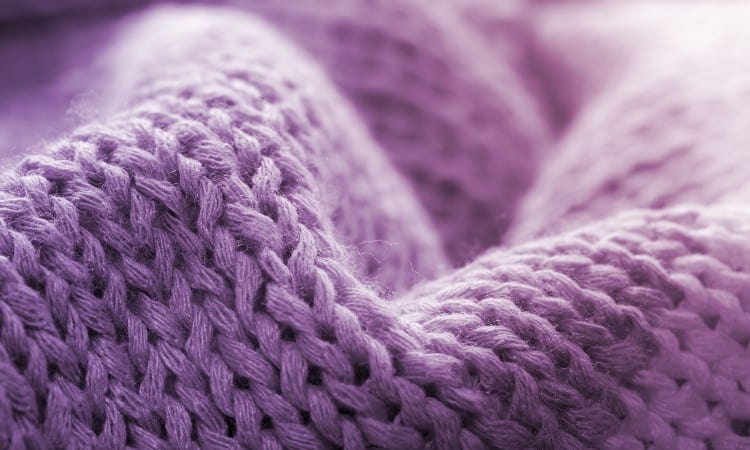
Can You Dye Wool?
Like most natural fibers, you can dye wool. It absorbs color well, and once the dye is set, the color stays vibrant for a long time.
However, unlike plant fibers made of cellulose, animal fibers like wool need dyes with a low pH measurement. They also need to be heat-set for the dye to bond to the fiber.
Wool is a protein fiber, which is a category that includes any animal-produced or insect-produced fiber built out of protein such as hair or fur. Sheep, llamas, goats, and rabbits all produce wool that we turn into the fabric, thread, and yarn.
While wool takes color well and you can dye it in a wide range of colors using many different kinds of dye, you need to be careful. It’s easy to accidentally damage wool when dyeing it if you try to treat it like cotton or synthetic fabric.
What to Consider When Dyeing Wool
The most important things to look out for when you’re dyeing wool are shrinkage and felting. Wool is temperature-sensitive, so if there is a sudden change in the temperature of the dye bath, the wool might shrink in response.
Excessive stirring or agitation can also shrink the wool or felt it. Felting is when the wool fibers start to fray and bond with the fibers near them, which changes the texture of the fabric. While felted wool is a dense, warm fabric with many uses, felting is not reversible. If you accidentally felt your wool fabric, there’s no do-over.
Other factors you should know when you dye wool are whether the fabric has been treated or chemically altered and what animal and breed the fiber came from. Superwash wools can take more heat and agitation because the manufacturer chemically altered or coated the fibers to prevent felting. This is more common on sheep wool than other types.
Check the garment washing instructions for clues if you don’t know the history of the fabric. If it says machine washable, it’s superwash. Hand-wash or dry-clean only fabrics are likely untreated and at risk of felting.
If you don’t have a garment tag, or if you’re working with yarn or fabric, you can check with the manufacturer for information on the wool type. This information will help you choose the best dye for your project.
Finally, as with any fabric dyeing project, working with chemicals can be dangerous. Make sure to wear the proper protective gear, such as gloves, a face mask, and safety glasses.
What Is The Best Dye for Wool?
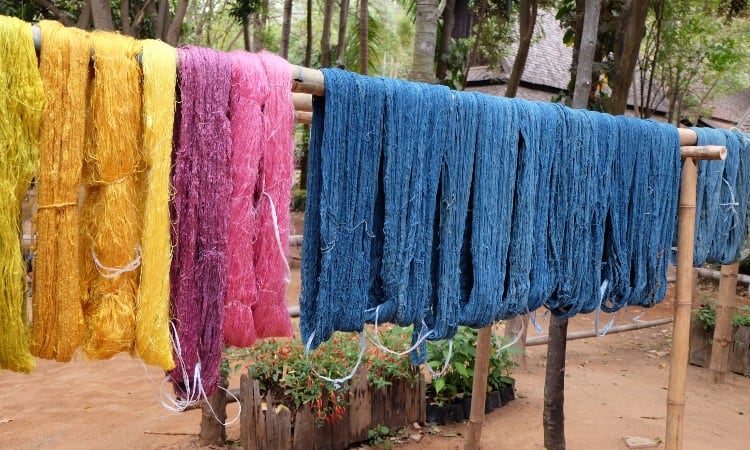
The most common dye for wool is an acid dye. Acid dye works best for wool in terms of getting the widest variety of vibrant, color-fast shades and long-lasting results. This kind of dye bonds well with protein fiber, and there are a variety of different acid dyes to choose from, based on how they bond with the fiber.
Acid dye and chemical reactions might sound intense and difficult, but that’s not the case. The best acids for wool dyeing have very low pH measurements. The techniques are no more complicated than cooking and measuring techniques. However, it is best to remember that working with chemicals can be dangerous, so use caution and wear gloves.
Best Acid Dyes for Wool
 There are two main types of acid dye for wool: powder and pre-mixed liquid dyes. Powder dyes give you more control over the shade variation. You can mix up more than one powder dye and combine the resulting liquid to make new colors easily. You also have better control over the concentration level, so you can make darker or paler colors.
There are two main types of acid dye for wool: powder and pre-mixed liquid dyes. Powder dyes give you more control over the shade variation. You can mix up more than one powder dye and combine the resulting liquid to make new colors easily. You also have better control over the concentration level, so you can make darker or paler colors.
Pre-mixed liquid dyes are less customizable but easier to learn how to use. They shorten the time you need for dye preparation, but it takes longer for them to set onto the wool fabric.
Powder and liquid acid dye will both give you long-lasting colorfast results, as long as you follow the directions on the dye package.
Lanaset Dye
Lanaset is a brand of wool dye that uses both fiber reactive and premetalized acid dyes. The brand is known for being washable and long-lasting, even in hot water washes. Lanaset dyes are also very resistant to light-based fading.
The shade range is limited, however, and difficult to obtain in some countries. You can mix their shades, even if they aren’t the same type of acid dye, to make custom colors. Make sure to test any mixtures you make on scrap fabric or yarn before dyeing a larger project.
Vinyl Sulfone Dye
Vinyl sulfone dyes are a fiber reactive dye normally used for silk, which also works for cotton and wool. The main benefit of vinyl sulfone dye is that it needs significantly more heat than other acid dyes to react, so manufacturers can sell it dissolved in water.
Having it in liquid form cuts out one of the trickier dye steps, so this is a great dye choice for novice dyers. The drawback is that it takes longer to work than other acid dyes, so you need to set aside at least a day for the process.
Fiber Reactive Dye
Fiber reactive dyes are dyes that form covalent bonds with the fiber you’re dyeing. That means the dye connects itself to the fiber molecules in a chemical reaction. This makes these dyes incredibly long-lasting and resistant to wash and wear.
There are fiber reactive dyes for various types of fiber, and many wool-specific acid dyes are fiber reactive. The difference between these dyes is what chemical is bonding to the wool fiber.
When you use a fiber reactive dye, you’re putting the wool in the right environment for a specific chemical reaction to take place. Always follow the directions on your dye carefully, and stick to vetted dye recipes so that you don’t accidentally make the wrong chemical reaction.
Natural Dyes for Wool
Natural dyes are not acid dye. However, to set a natural dye in wool fiber, you do need a mordant. Mordants are substances you use to help a dye bond with a fiber. In the case of wool dyeing, the most common mordants are acids, like alum or even white vinegar.
Wool is one of the oldest textile fibers, so people have been dyeing it with natural dyes for centuries. Plants, including roots, berries, bark, and flowers, are common natural dyes. Make sure to use a vetted dye recipe when working with natural dyes to avoid unwanted chemical reactions. This will keep you safe and avoid spoiling your wool.
How to Dye Wool With Acid Dyes
Wool needs two things to set the dye and keep the color: heat and a mild acid. Without them, you might be able to temporarily stain the wool, but it won’t last through washing and it will fade rapidly.
The exact details, such as temperature, amount of acid, how much dye, and how long the process takes, will vary based on the type of dye you choose and the kind of wool you’re dyeing. However, the basic steps for all acid dyes are the same:
- Soak the wool in a solution of water and mild acid
- Mix and prepare your dye
- Pour the dye onto your wool/into the dyebath
- Heat the dyebath to set the color
- Gently rinse the wool and hang or lay flat to dry
Soaking the yarn helps open up the fiber to take dye in more easily, and the acid helps the dye bond to the fiber. The heat sets it and finishes the chemical reaction. How you add the dye depends on what you want the final product to look like.
For solid colors, you’ll have better luck adding the dye to the water and vinegar mixture and stirring it gently so that all the surfaces of the wool are soaked in dye. For speckles or multiple colors or other effects, you can put the dye mixture directly onto the wool.
These same steps work for not just chemical dyes but for botanical and household dyes as well.
How to Dye Wool Naturally
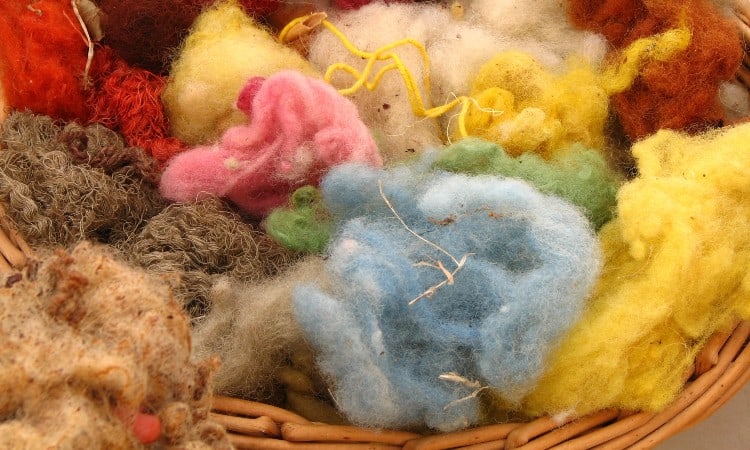
Coffee, tea, onion skins, turmeric, avocado pits, crushed berries, and more all make excellent wool dyes. Any botanical you can extract dye from has the potential to be a good wool dye.
The process for using a natural dye is the same as a chemical dye: you soak the yarn in water and mordant, then cook it in a dye bath with your prepared dye, rinse it, and dry it. The main difference is how you prepare the dye.
Extracting color from botanical material is an easy process. The most straightforward way is to cut up the material–bark, flowers, berries, roots, etc.–and then simmer it in water for an hour or so. A ratio of 2:1 water to botanicals is a good starting point.
Once you’ve simmered the mixture, let it cool. Soak it at least overnight, then strain out any solid pieces still in the mixture if you want. You can leave them in, but if you have bark or anything spiny, it could get stuck in your fabric and you may want to remove it.
The other thing you need to adjust when you’re using a natural or botanical dye is the acid you use for your mordant. Look up the pH of whatever natural material you’re using, and adjust the amount or type of mordant you use so that you don’t overload your dye bath with too much acid.
Solar Dyeing
Another way to use natural dyes is with solar dyeing. The only difference between solar dyeing and dyeing yarn on a stovetop is that instead of soaking it for half an hour on the stove, you let the sun do the work.
You will still pre-soak the yarn in water and acid, but instead of using a pot, you can use a jar or bucket with a lid. You can either prepare your dye in the jar and then add the wool or prepare it separately and add it to the jar at the same time as the wool. Once the wool is submerged in the dye bath in the jar, seal it up and leave it outside in the sun.
Solar dyeing is a slow process as it is a lower, less concentrated heat source. The longer you leave the jar, the stronger the final color result will be! Once you’ve soaked it as much as you want, rinse and dry as normal.
Can You Dye Wool with Other Household Items?
Plants aren’t the only non-commercial dyes you can use on your wool. Food coloring and even Kool-Aid packets also work well on wool.
If you have food coloring and white vinegar in your kitchen cabinets, you have all the ingredients you need to dye wool. Using food dyes to dye wool is a great way to learn about wool dyeing as they are much milder than commercial chemical dyes.
As with any wool dye, make sure to stick to tried and tested recipes. This will both get you the best possible color results and help protect you from accidentally hurting yourself.
How to Dye Merino Wool Sweater
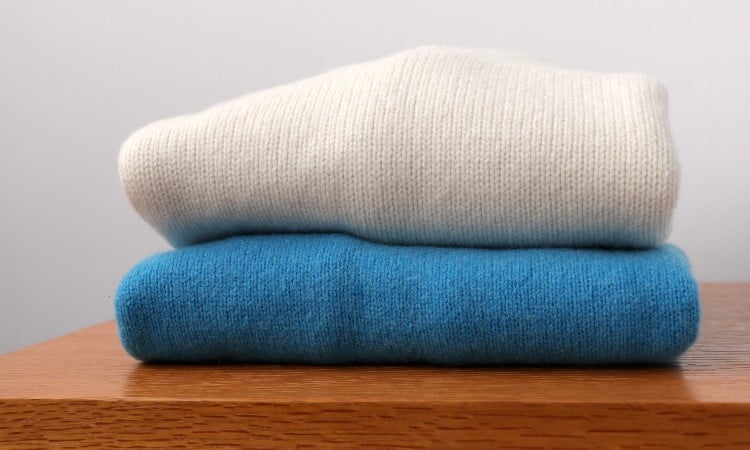
To dye a merino wool sweater, you’ll need a pot big enough to submerge the entire sweater, white vinegar, an acid dye, and a stovetop. Gloves, a metal spoon or tongs, and a lid for the pot will be helpful too. It’s best to use a pot and tongs that you do not cook with to avoid cross-contamination.
Soak the clean sweater in a mixture of lukewarm water and about a cup of vinegar. You can use your kitchen sink for this or a clean pot or bowl. Next, prepare your dye according to the package directions. Usually, this means dissolving it in hot water.
To dye the whole sweater one color:
- Add the dye to your dye pot with enough water to cover the sweater.
- Put the sweater in the pot and gently stir with the spoon or tongs to cover it.
- Don’t squeeze out the vinegar first; just transfer the sweater.
Add your sweater to the pot with enough water to cover it for multiple colors or a variegated look. Then, pour the dye colors over the sweater in the areas you want to dye. Make sure the whole sweater is submerged, even if there isn’t dye on every part of it.
Keep the heat on, but don’t let it get above a simmer. The sweater should stay in the dyebath for thirty minutes. You can stir it once or twice, but be gentle as too much movement can cause felting or shrinkage. Afterward, take the pot off the heat and carefully pour out the dye mixture, or take the sweater out with your tongs. Let the sweater cool down, then rinse it until the water runs clear.
Lay the sweater out flat to dry, and you’re all set!
Can you Tie-Dye Wool?
You can tie-dye wool, but it is a slightly different process from tie-dying cotton clothing. The dye steps are the same as for any other wool dyeing: you have to soak it in water, then add a mordant and the dye, cook it, rinse it, and dry it.
To get the tie-dye effect, you would need to fasten rubber bands around the fabric or garment before you soak it in water. Then, you can apply the dye with a syringe or turkey baster to the areas you want it.
Once the color is in place, you need to heat the fabric. You can do this on the stovetop (make sure the wool is submerged in water; do not cook it in an empty pot!), or wrap the damp wool in plastic wrap and microwave it for several minutes.
After it cooks, cool it down by letting it sit out at room temperature. Then rinse and air dry as normal! It may not be as crisp as cotton tie-dye, but it will have the same general effect.
How to Dye Wool Yarn
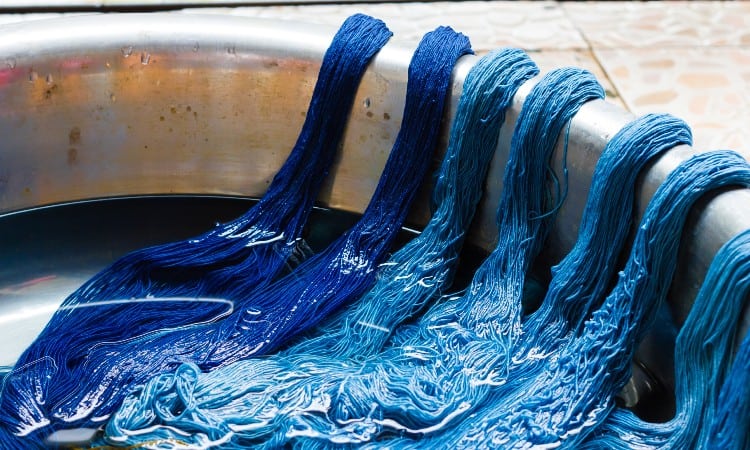
The way you dye wool yarn is the same in principle as to how you dye wool fabric or garments. It is the same type of fiber, so it has the same chemical reactions as wool fabric. It also carries the same risks of shrinkage and felting.
The difference between dyeing wool fabric and dyeing wool yarn is what the finished fiber will look like. It is much harder to get a solid color on yarn than fabric because there are many more available surfaces. There will always be more color variation on a hank of hand-dyed yarn than on a yard of hand-dyed fabric.
However, that also means that you can add more different colors to hand-dyed yarn without creating a murky mess. Dyeing yarn is also a relatively inexpensive way to experiment with wool dyes to get a feel for how they work before you plunge your expensive wool garments into a dyebath.
Conclusion
Dyeing wool might seem complicated on the surface, but with patience, heat, acid, and dye, you can make wool the color of your dreams. Whether you’re excited to forage for a botanical color or make the perfect mix with dye powder, now you know all the steps to make it happen.
Have you ever dyed wool? Leave a comment to tell us about the experience!
Hania Roe
Monday 6th of March 2023
Enjoyed all your helpful comments. Thanks, but I wonder if I can over-dye wool if it doesn’t come out just the right shade at the first attempt? I followed all your points and dyed alpaca wool, but didn’t have enough dye crystals. It has come out too light. Can I go through the whole process again with fresh dye?